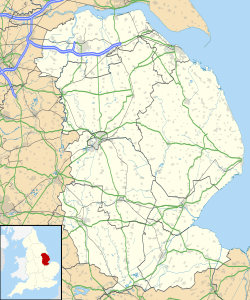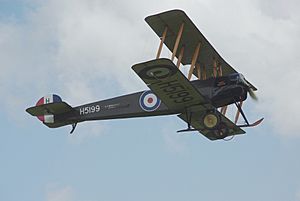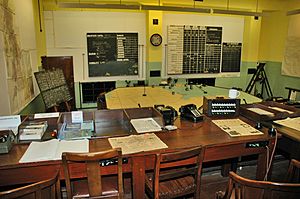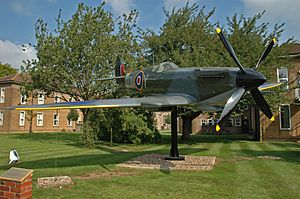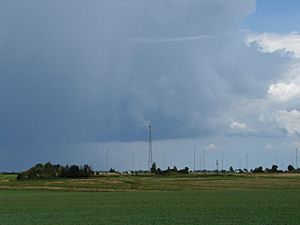RAF Digby facts for kids
Quick facts for kids RAF Digby
|
|||||||||||
|---|---|---|---|---|---|---|---|---|---|---|---|
| Near Scopwick, Lincolnshire in England | |||||||||||
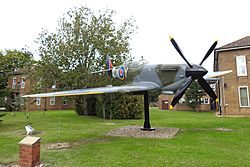
Replica Spitfire as gate guardian
|
|||||||||||
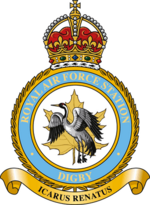
|
|||||||||||
|
Shown within Lincolnshire
|
|||||||||||
| Coordinates | 53°05′27″N 000°26′03″W / 53.09083°N 0.43417°W | ||||||||||
| Type | Joint signals intelligence station | ||||||||||
| Area | 171 hectares | ||||||||||
| Site information | |||||||||||
| Owner | Ministry of Defence | ||||||||||
| Operator | Royal Air Force and Strategic Command | ||||||||||
| Site history | |||||||||||
| Built | 1918 | ||||||||||
| In use | 1918–present | ||||||||||
| Airfield information | |||||||||||
| Elevation | 61 metres (200 ft) AMSL | ||||||||||
|
|||||||||||
RAF Digby is a special base for the Royal Air Force (RAF) located near Scopwick in Lincolnshire, England. It's about 11.6 mi (18.7 km) south-east of Lincoln. This base is home to the Joint Service Signals Organisation, which is part of the UK's Strategic Command.
RAF Digby is one of the oldest RAF stations in the country. It started as a training and fighter airfield. However, planes stopped flying from Digby in 1953. Today, it focuses on signals intelligence and training.
Contents
History of RAF Digby
Early Days: First World War
RAF Digby began its life as an airfield even before the RAF officially existed. Photos from 1917 show that Royal Naval pilots were already training there. The site was officially taken over in January 1918.
The first pilots arrived on March 28, 1918. They were led by Major John H D’Albiac. The base was known as RAF Scopwick back then. Just a few days later, on April 1, 1918, the Royal Air Force was officially formed.
Initially, RAF Scopwick was a training base for night bomber pilots. It had planes like the Handley Page 0/100s and Avro 504Ks. During the First World War, the base saw a German Zeppelin try to bomb it, but the bombs missed.
Between the World Wars
In April 1920, the base became No. 3 Flying Training School RAF. Its first commander was Squadron Leader A T Harris, who later became a famous Air Marshal. Five months later, the name changed from Scopwick to RAF Digby. This was because mail and parts often went to the wrong base!
The station's role also changed from training bomber pilots to training fighter pilots. For a short time, the base closed in 1922. But it reopened in 1924 as No. 2 Flying Training School RAF. This school taught new pilots to fly fighter planes directly. Many important leaders worked at Digby during this time. These included Wing Commander Arthur Tedder and Group Captain T Leigh-Mallory. Both became very important figures in the RAF.
Between 1929 and 1936, the base was rebuilt. Many old wooden buildings were replaced with strong brick ones. A special underground bunker, the No. 12 Group RAF Lima Sector Operations bunker, was built in 1936. Today, this bunker is the station museum.
In 1937, RAF Digby became an operational fighter station. Its job was to protect cities like Lincoln, Nottingham, and Leicester. Soon, squadrons flying Gloster Gladiators, Gloster Gauntlets, and Hawker Hurricanes were based there.
Second World War Operations
When the Second World War began in September 1939, RAF Digby was ready. Its squadrons were quickly scrambled to check for German raids. In October 1939, more squadrons arrived, including No. 611 Squadron RAF with their Supermarine Spitfires.
A famous pilot, Guy Gibson, who later led the Dambusters, was based at Digby. He had even learned to fly there in 1936. In late 1939, King George VI visited RAF Digby and gave awards to pilots, including Guy Gibson.
In May and June 1940, No. 222 Squadron RAF rested at Digby after fighting in the Battle of Britain. One of their most famous pilots was Flight Lieutenant Douglas Bader, a fighter ace who flew with artificial legs.
In August 1940, a German bomber dropped bombs on the station, but they landed harmlessly. In 1941, Canadian fighter squadrons arrived, including No. 401 Squadron RCAF and No. 402 Squadron RCAF. They flew Hurricanes and Spitfires. Digby became a key base for Canadian air forces.
RAF Digby was bombed several times in 1941. Because of this, the main operations centre moved to a safer place at Blankney Hall. Many other RAF squadrons also came to Digby for rest.
A young American pilot and poet, John Gillespie Magee Jr., was killed in a mid-air collision near Digby in December 1941. He was only 19. His grave in Scopwick churchyard has lines from his famous poem "High Flight."
A brave bomb disposal expert, Flight Sergeant Hanford, safely disarmed dangerous German "butterfly bombs" that had fallen nearby. His actions helped experts learn how to deal with these tricky bombs. He received the British Empire Medal for his courage.
RCAF Digby: Canadian Control
On September 16, 1942, Canada took control of the base, and it was renamed Royal Canadian Air Force Station Digby. In 1943, de Havilland Mosquito planes arrived.
In early 1944, Digby was very busy. Many squadrons, including Czech and Belgian ones, trained for the D-Day invasion. After the invasion, most squadrons moved to airfields in France. Digby became much quieter.
In May 1945, control returned to the British, and it became RAF Digby again. The new station badge included a maple leaf to remember its Canadian history. By the end of the war, Digby had hosted many squadrons from different countries.
After the War
After World War II, Digby's role changed. It became a non-flying base for RAF training. Various schools, like the Secretarial Branch Training School, moved there. In 1951, the No. 2 Aircrew Grading School helped decide if people could become pilots or other aircrew.
The station's badge, awarded in 1952, shows a white crane over a maple leaf. Its motto, Icarus Renatus, means Icarus Reborn. This refers to the base being closed for a short time and then reopened.
Flying stopped at Digby in January 1953. The base was then prepared for new signals units. In 1955, No. 399 Signals Unit and No. 591 Signals Unit arrived. They focused on signals intelligence.
The base continued to grow, with British Army and Royal Navy teams joining. American teams also arrived. In 1998, several signals units combined to form the Joint Service Signal Unit (Digby).
Today, No. 54 Signals Unit, established in 2014, processes electronic information gathered by UK aircraft.
What Happens at RAF Digby Today
RAF Digby is now a key base for gathering and understanding electronic signals. It's a joint service station, meaning people from the Army, Navy, and Air Force work there.
Joint Service Signals Organisation
This group helps the UK government make important decisions and supports military operations. They research new ways to communicate and provide support to armed forces units. The Joint Service Signal Unit (Digby) is part of this organisation.
No. 591 Signals Unit
This unit focuses on communications and electronic security. They monitor electronic signals and provide services to the RAF, especially during deployed operations.
Aerial Erector School
This school trains military personnel and civilians. They learn how to set up and maintain the large aerials and antennas needed for communications and signals intelligence.
Air Training Corps
RAF Digby is also home to the Headquarters Trent Wing of the Air Training Corps. This group manages staff and cadets from 31 squadrons across Lincolnshire, Nottinghamshire, and Derbyshire.
Station Museum
The Sector Operations Room Museum at RAF Digby shows what the base was like in 1939. It's open to the public on Sundays from May to October, or by special arrangement. It's a great way to learn about the base's history.
See also
- List of Royal Air Force stations


